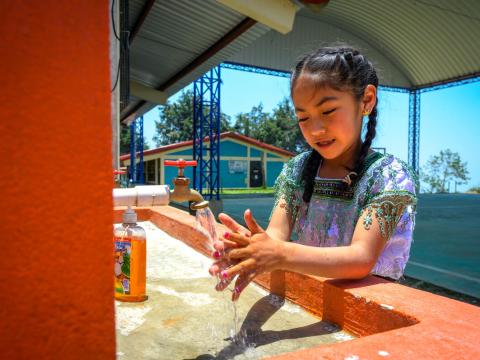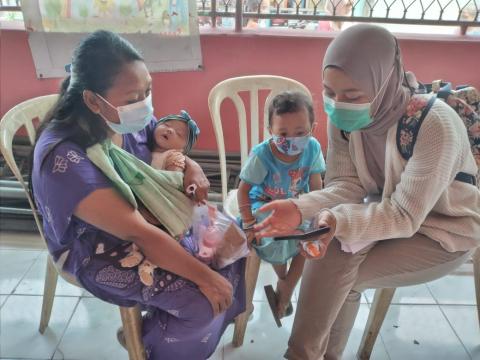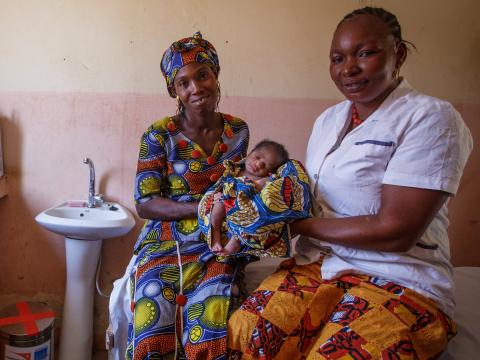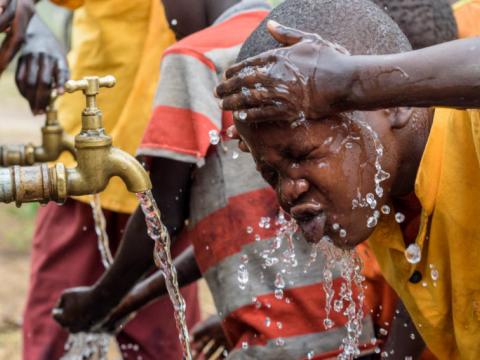
Handwashing still a life and death issue for children
For Global Handwashing Day Lindsay appeals for governments to promote handwashing and ensure clean hands are within reach as they did during the COVID-19 pandemic
During the first years of the COVID pandemic, handwashing was a hot topic in the media, in government guidance, and in conversation. In the US, I couldn’t go anywhere, be it the grocery store or my child’s school, without seeing multiple containers of hand sanitizer and signs reminding people to wash their hands frequently. It was one of the pillars of COVID prevention, and it was everywhere.
Fast forward to today and hand hygiene is not the trending topic it once was. Though the critical nature of handwashing has mostly fallen out of public consciousness, we must not let it.
Handwashing is one of the best tools we have to prevent the spread of disease, including diseases that kill thousands of children each and every day.

A new report from WHO estimates that unsafe hand hygiene is responsible for 384,000 diarrhoea deaths and 356,000 deaths from acute respiratory infections (ARIs) per year. Diarrhoea and ARIs are the two biggest infectious killers of children under five globally, and the act of handwashing with soap can reduce the risk of diarrhoea by 30% and ARIs by 17%. Yet, 2 billion people do not have a handwashing station with soap and water at home and only 26% of people globally wash their hands at critical times.
Increasing access to long-lasting hygiene infrastructure, including a durable station with running water and soap, combined with effective behaviour-change programming are key to successfully increasing handwashing.
At World Vision, we have shifted our focus from community wells with hand pumps to piped water systems that deliver water close to home. Piped water systems have many advantages over hand pumps, including reducing the risk of water contamination, relieving women and girls of the burden of long journeys to collect water, providing water for toilets, and distributing larger volumes of water to support livelihoods and economic opportunities. In 2022, 70% of the water points we installed were household taps (up from 34% in 2020).

Unsurprisingly, having water closer to the home also increases handwashing rates. A study of World Vision piped water systems in Zambia showed that when the distance from the water source to the home was reduced by 90%, hand contamination fell by 68%. Providing reliable piped-water service allows for more water to be readily available, meaning more water can be used for handwashing.
In addition to bringing clean water to homes, we are promoting longer lasting handwashing infrastructure at households, schools and healthcare facilities. Families, students and healthcare providers need handwashing facilities that are durable, reliable, affordable and convenient. Behaviour change approaches are not enough on their own; we must also provide the right conditions for people to wash their hands to create a lasting habit.

This Global Handwashing Day, we must reinvigorate the conversation around handwashing. Governments need to prioritise handwashing by making it a public policy goal backed by clear targets and a real budget. In addition to saving hundreds of thousands of lives each year, focusing on handwashing now also better prepares us for the next pandemic. Though it may feel less critical than it did in 2020, handwashing is still a life and death issue for millions of children around the world. Now is not the time for complacency. Now is the time to act.
To learn more about World Vision's water, sanitation and hygiene work click here
Lindsay Lange is World Vision International’s WASH Knowledge Management and Capability Advisor. She leads World Vision’s WASH Community of Practice and provides WASH staff around the world with resources and trainings to help them implement high quality programmes. She has 15 years of experience in WASH and global health programmes, and she has a master’s in public health from the Johns Hopkins School of Public Health.


